Tires BMW X3 3.0I 2005 E83 Owner's Manual
[x] Cancel search | Manufacturer: BMW, Model Year: 2005, Model line: X3 3.0I, Model: BMW X3 3.0I 2005 E83Pages: 126, PDF Size: 4.65 MB
Page 4 of 126
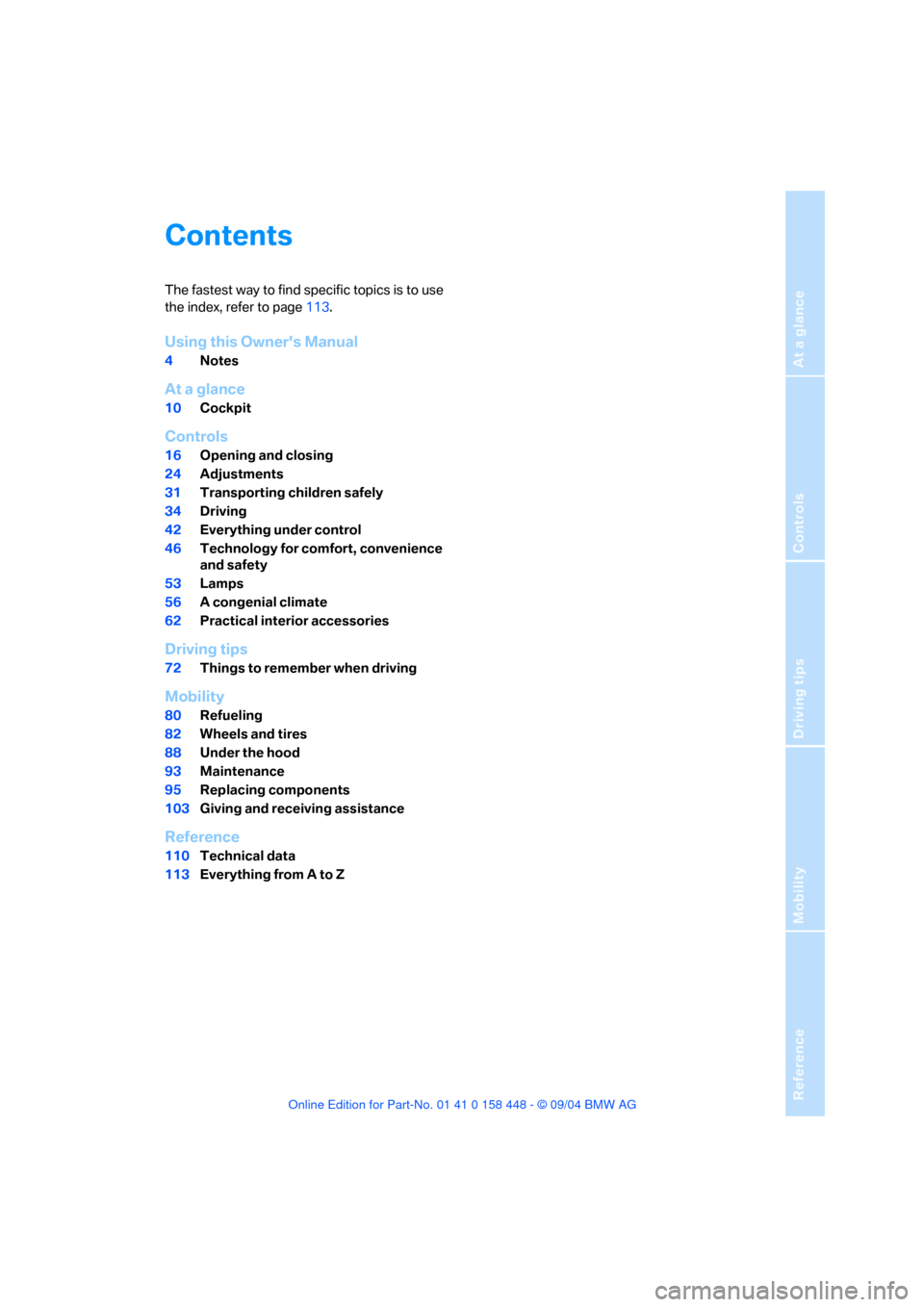
Reference
At a glance
Controls
Driving tips
Mobility
Contents
The fastest way to find specific topics is to use
the index, refer to page113.
Using this Owner's Manual
4Notes
At a glance
10Cockpit
Controls
16Opening and closing
24Adjustments
31Transporting children safely
34Driving
42Everything under control
46Technology for comfort, convenience
and safety
53Lamps
56A congenial climate
62Practical interior accessories
Driving tips
72Things to remember when driving
Mobility
80Refueling
82Wheels and tires
88Under the hood
93Maintenance
95Replacing components
103Giving and receiving assistance
Reference
110Technical data
113Everything from A to Z
Page 50 of 126
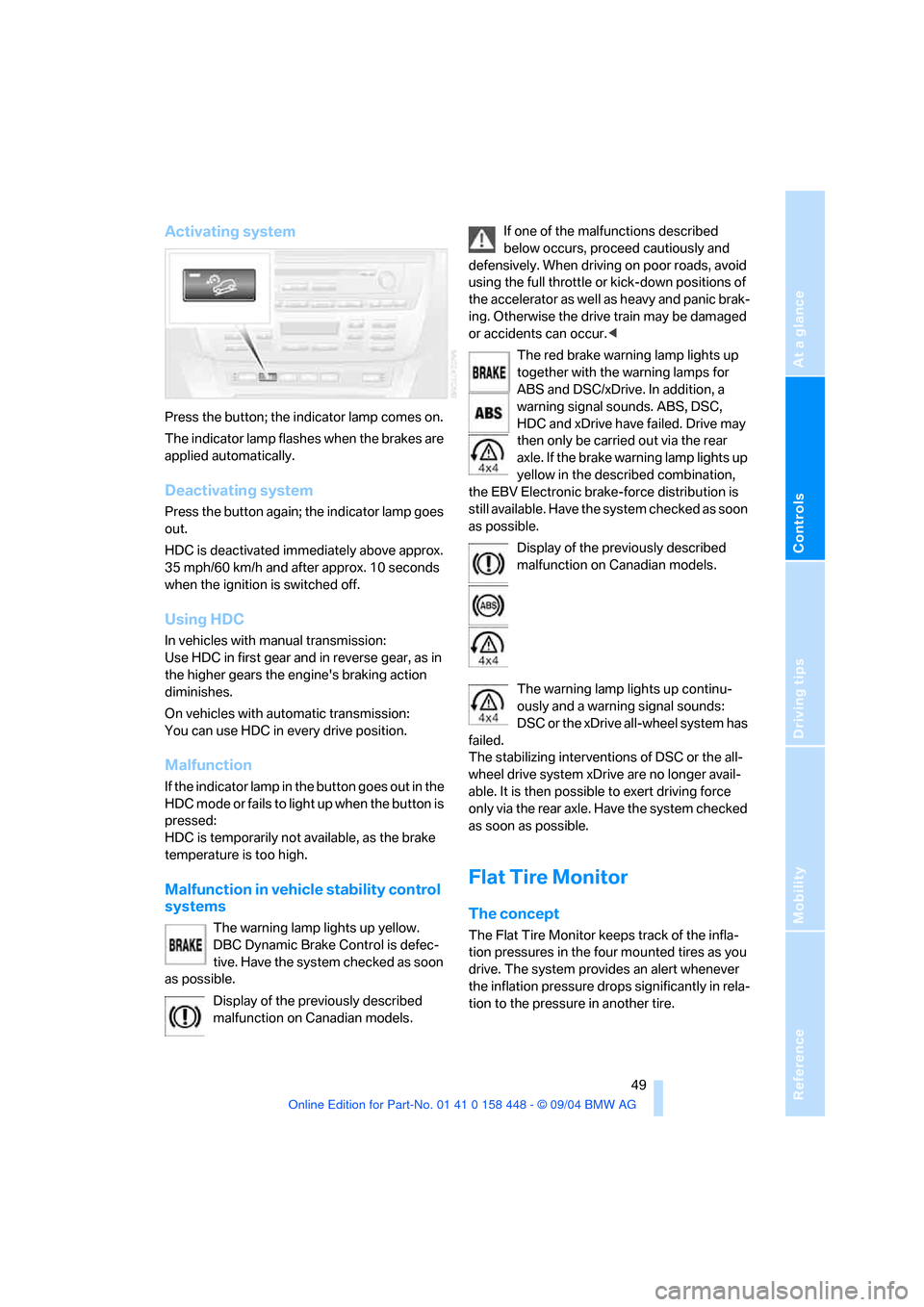
Reference
At a glance
Controls
Driving tips
Mobility
49
Activating system
Press the button; the indicator lamp comes on.
The indicator lamp flashes when the brakes are
applied automatically.
Deactivating system
Press the button again; the indicator lamp goes
out.
HDC is deactivated immediately above approx.
35 mph/60 km/h and after approx. 10 seconds
when the ignition is switched off.
Using HDC
In vehicles with manual transmission:
Use HDC in first gear and in reverse gear, as in
the higher gears the engine's braking action
diminishes.
On vehicles with automatic transmission:
You can use HDC in every drive position.
Malfunction
If the indicator lamp in the button goes out in the
HDC mode or fails to light up when the button is
pressed:
HDC is temporarily not available, as the brake
temperature is too high.
Malfunction in vehicle stability control
systems
The warning lamp lights up yellow.
DBC Dynamic Brake Control is defec-
tive. Have the system checked as soon
as possible.
Display of the previously described
malfunction on Canadian models.If one of the malfunctions described
below occurs, proceed cautiously and
defensively. When driving on poor roads, avoid
using the full throttle or kick-down positions of
the accelerator as well as heavy and panic brak-
ing. Otherwise the drive train may be damaged
or accidents can occur.<
The red brake warning lamp lights up
together with the warning lamps for
ABS and DSC/xDrive. In addition, a
warning signal sounds. ABS, DSC,
HDC and xDrive have failed. Drive may
then only be carried out via the rear
axle. If the brake warning lamp lights up
yellow in the described combination,
the EBV Electronic brake-force distribution is
still available. Have the system checked as soon
as possible.
Display of the previously described
malfunction on Canadian models.
The warning lamp lights up continu-
ously and a warning signal sounds:
DSC or the xDrive all-wheel system has
failed.
The stabilizing interventions of DSC or the all-
wheel drive system xDrive are no longer avail-
able. It is then possible to exert driving force
only via the rear axle. Have the system checked
as soon as possible.
Flat Tire Monitor
The concept
The Flat Tire Monitor keeps track of the infla-
tion pressures in the four mounted tires as you
drive. The system provides an alert whenever
the inflation pressure drops significantly in rela-
tion to the pressure in another tire.
Page 51 of 126
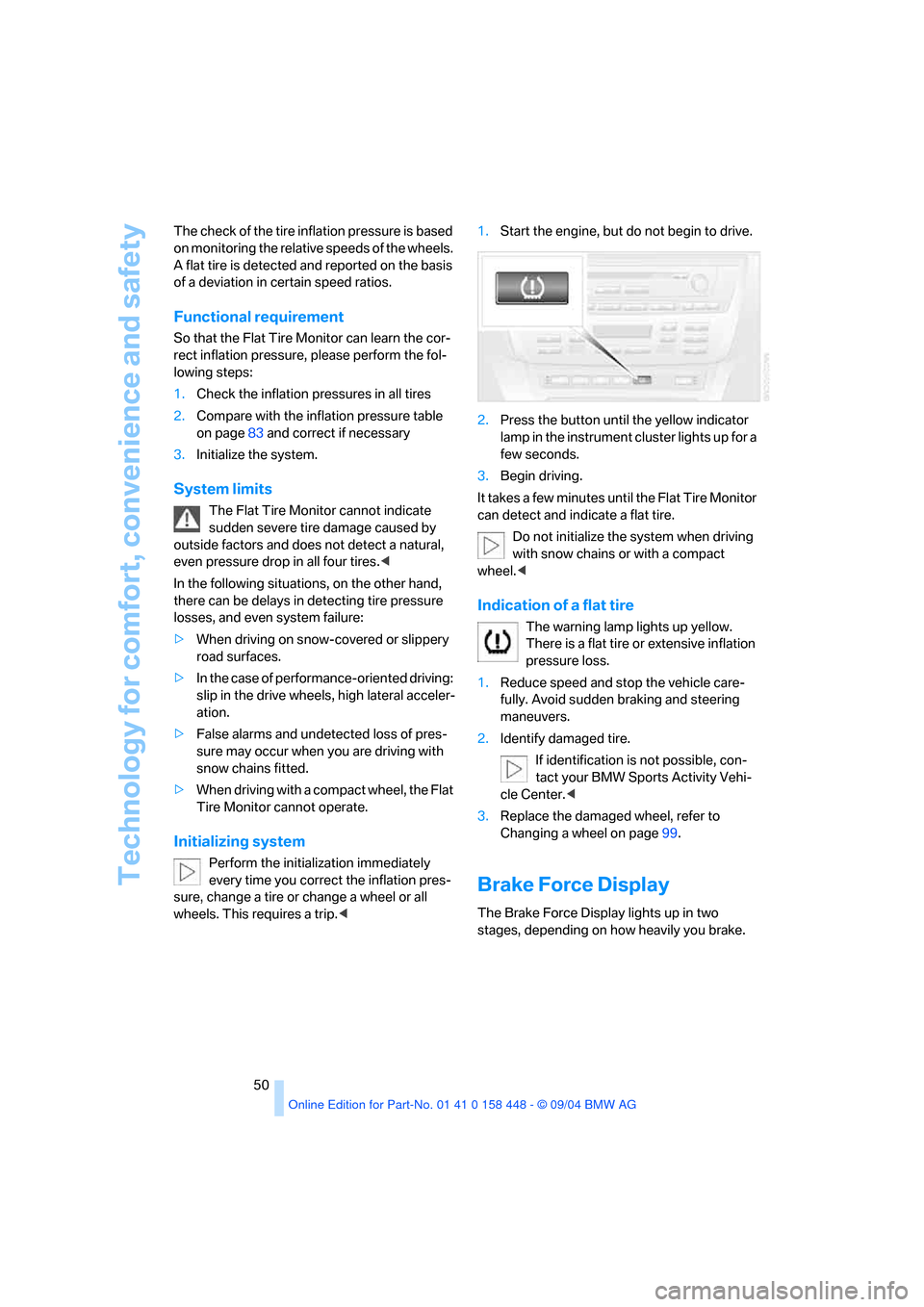
Technology for comfort, convenience and safety
50 The check of the tire inflation pressure is based
on monitoring the relative speeds of the wheels.
A flat tire is detected and reported on the basis
of a deviation in certain speed ratios.
Functional requirement
So that the Flat Tire Monitor can learn the cor-
rect inflation pressure, please perform the fol-
lowing steps:
1.Check the inflation pressures in all tires
2.Compare with the inflation pressure table
on page83 and correct if necessary
3.Initialize the system.
System limits
The Flat Tire Monitor cannot indicate
sudden severe tire damage caused by
outside factors and does not detect a natural,
even pressure drop in all four tires.<
In the following situations, on the other hand,
there can be delays in detecting tire pressure
losses, and even system failure:
>When driving on snow-covered or slippery
road surfaces.
>In the case of performance-oriented driving:
slip in the drive wheels, high lateral acceler-
ation.
>False alarms and undetected loss of pres-
sure may occur when you are driving with
snow chains fitted.
>When driving with a compact wheel, the Flat
Tire Monitor cannot operate.
Initializing system
Perform the initialization immediately
every time you correct the inflation pres-
sure, change a tire or change a wheel or all
wheels. This requires a trip.<1.Start the engine, but do not begin to drive.
2.Press the button until the yellow indicator
lamp in the instrument cluster lights up for a
few seconds.
3.Begin driving.
It takes a few minutes until the Flat Tire Monitor
can detect and indicate a flat tire.
Do not initialize the system when driving
with snow chains or with a compact
wheel.<
Indication of a flat tire
The warning lamp lights up yellow.
There is a flat tire or extensive inflation
pressure loss.
1.Reduce speed and stop the vehicle care-
fully. Avoid sudden braking and steering
maneuvers.
2.Identify damaged tire.
If identification is not possible, con-
tact your BMW Sports Activity Vehi-
cle Center.<
3.Replace the damaged wheel, refer to
Changing a wheel on page99.
Brake Force Display
The Brake Force Display lights up in two
stages, depending on how heavily you brake.
Page 73 of 126
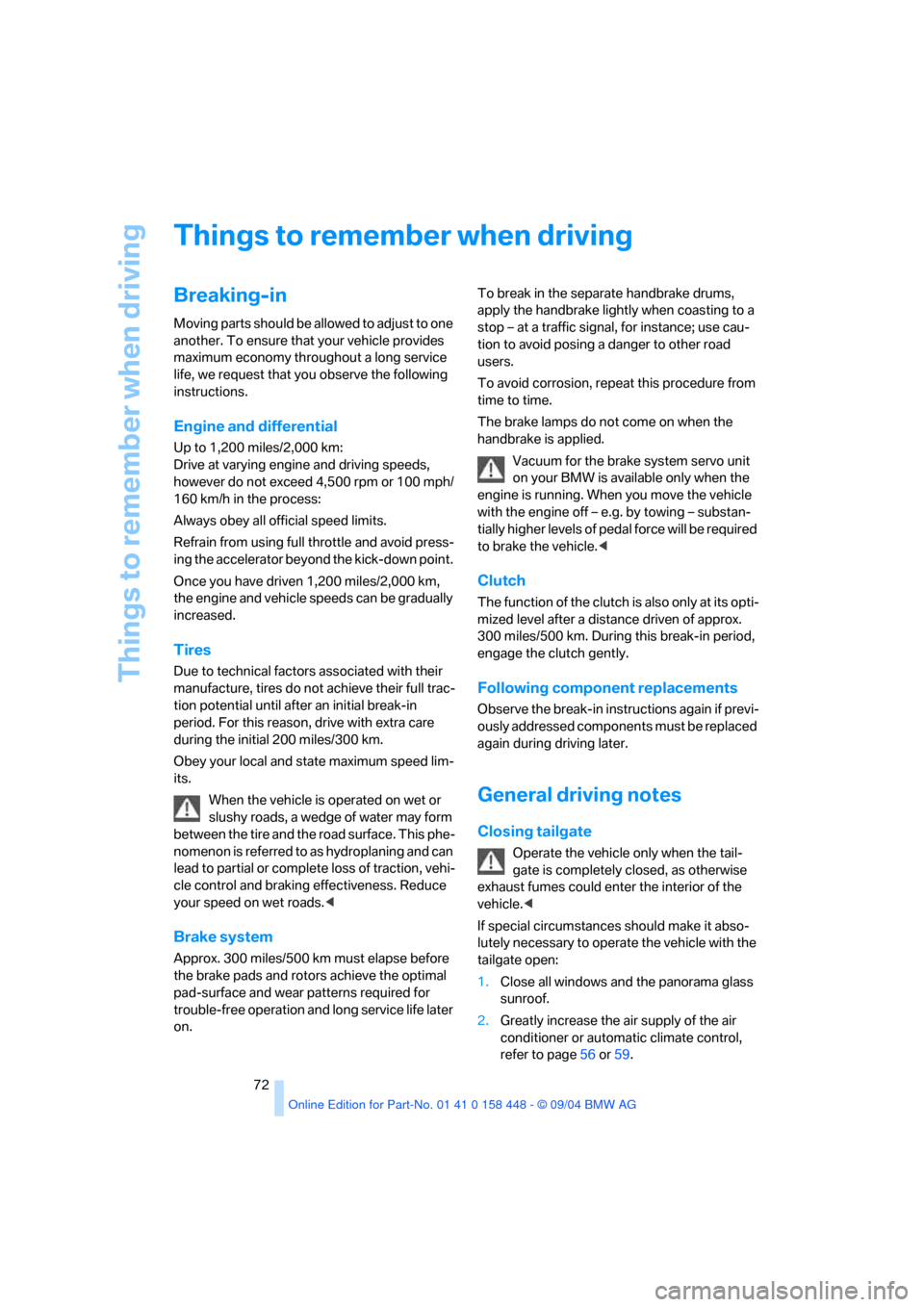
Things to remember when driving
72
Things to remember when driving
Breaking-in
Moving parts should be allowed to adjust to one
another. To ensure that your vehicle provides
maximum economy throughout a long service
life, we request that you observe the following
instructions.
Engine and differential
Up to 1,200 miles/2,000 km:
Drive at varying engine and driving speeds,
however do not exceed 4,500 rpm or 100 mph/
160 km/h in the process:
Always obey all official speed limits.
Refrain from using full throttle and avoid press-
ing the accelerator beyond the kick-down point.
Once you have driven 1,200 miles/2,000 km,
the engine and vehicle speeds can be gradually
increased.
Tires
Due to technical factors associated with their
manufacture, tires do not achieve their full trac-
tion potential until after an initial break-in
period. For this reason, drive with extra care
during the initial 200 miles/300 km.
Obey your local and state maximum speed lim-
its.
When the vehicle is operated on wet or
slushy roads, a wedge of water may form
between the tire and the road surface. This phe-
nomenon is referred to as hydroplaning and can
lead to partial or complete loss of traction, vehi-
cle control and braking effectiveness. Reduce
your speed on wet roads.<
Brake system
Approx. 300 miles/500 km must elapse before
the brake pads and rotors achieve the optimal
pad-surface and wear patterns required for
trouble-free operation and long service life later
on. To break in the separate handbrake drums,
apply the handbrake lightly when coasting to a
stop – at a traffic signal, for instance; use cau-
tion to avoid posing a danger to other road
users.
To avoid corrosion, repeat this procedure from
time to time.
The brake lamps do not come on when the
handbrake is applied.
Vacuum for the brake system servo unit
on your BMW is available only when the
engine is running. When you move the vehicle
with the engine off – e.g. by towing – substan-
tially higher levels of pedal force will be required
to brake the vehicle.<
Clutch
The functio n of the clutch is als o only at its o pti-
mized level after a distance driven of approx.
300 miles/500 km. During this break-in period,
engage the clutch gently.
Following component replacements
Observe the break-in instructions again if previ-
ously addressed components must be replaced
again during driving later.
General driving notes
Closing tailgate
Operate the vehicle only when the tail-
gate is completely closed, as otherwise
exhaust fumes could enter the interior of the
vehicle.<
If special circumstances should make it abso-
lutely necessary to operate the vehicle with the
tailgate open:
1.Close all windows and the panorama glass
sunroof.
2.Greatly increase the air supply of the air
conditioner or automatic climate control,
refer to page56 or59.
Page 74 of 126
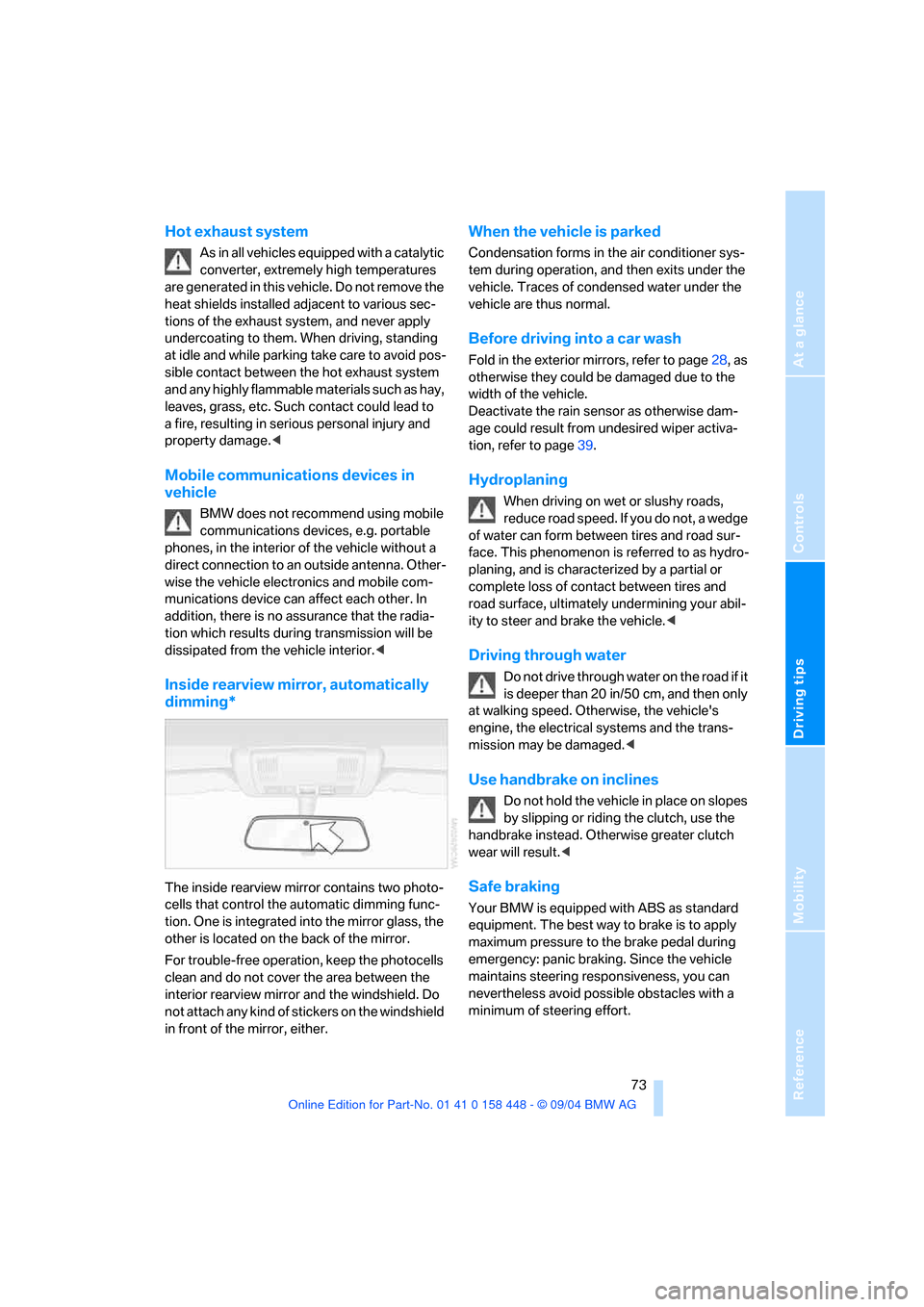
Reference
At a glance
Controls
Driving tips
Mobility
73
Hot exhaust system
As in all vehicles equipped with a catalytic
converter, extremely high temperatures
are generated in this vehicle. Do not remove the
heat shields installed adjacent to various sec-
tions of the exhaust system, and never apply
undercoating to them. When driving, standing
at idle and while parking take care to avoid pos-
sible contact between the hot exhaust system
and any highly flammable materials such as hay,
leaves, grass, etc. Such contact could lead to
a fire, resulting in serious personal injury and
property damage.<
Mobile communications devices in
vehicle
BMW does not recommend using mobile
communications devices, e.g. portable
phones, in the interior of the vehicle without a
direct connection to an outside antenna. Other-
wise the vehicle electronics and mobile com-
munications device can affect each other. In
addition, there is no assurance that the radia-
tion which results during transmission will be
dissipated from the vehicle interior.<
Inside rearview mirror, automatically
dimming*
The inside rearview mirror contains two photo-
cells that control the automatic dimming func-
tion. One is integrated into the mirror glass, the
other is located on the back of the mirror.
For trouble-free operation, keep the photocells
clean and do not cover the area between the
interior rearview mirror and the windshield. Do
not attach any kind of stickers on the windshield
in front of the mirror, either.
When the vehicle is parked
Condensation forms in the air conditioner sys-
tem during operation, and then exits under the
vehicle. Traces of condensed water under the
vehicle are thus normal.
Before driving into a car wash
Fold in the exterior mirrors, refer to page28, as
otherwise they could be damaged due to the
width of the vehicle.
Deactivate the rain sensor as otherwise dam-
age could result from undesired wiper activa-
tion, refer to page39.
Hydroplaning
When driving on wet or slushy roads,
reduce road speed. If you do not, a wedge
of water can form between tires and road sur-
face. This phenomenon is referred to as hydro-
planing, and is characterized by a partial or
complete loss of contact between tires and
road surface, ultimately undermining your abil-
ity to steer and brake the vehicle.<
Driving through water
Do not drive through water on the road if it
is deeper than 20 in/50 cm, and then only
at walking speed. Otherwise, the vehicle's
engine, the electrical systems and the trans-
mission may be damaged.<
Use handbrake on inclines
Do not hold the vehicle in place on slopes
by slipping or riding the clutch, use the
handbrake instead. Otherwise greater clutch
wear will result.<
Safe braking
Your BMW is equipped with ABS as standard
equipment. The best way to brake is to apply
maximum pressure to the brake pedal during
emergency: panic braking. Since the vehicle
maintains steering responsiveness, you can
nevertheless avoid possible obstacles with a
minimum of steering effort.
Page 75 of 126
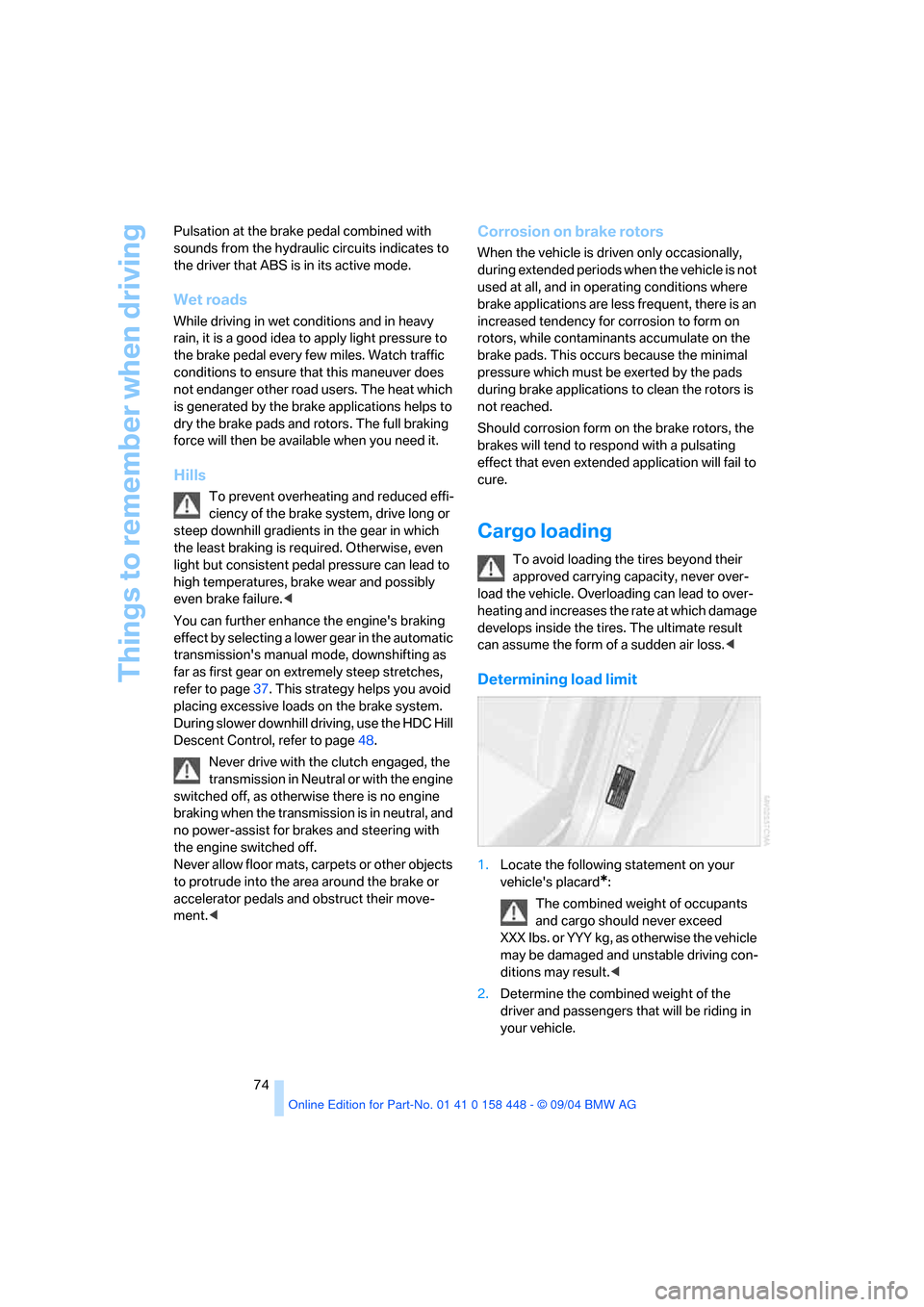
Things to remember when driving
74 Pulsation at the brake pedal combined with
sounds from the hydraulic circuits indicates to
the driver that ABS is in its active mode.
Wet roads
While driving in wet conditions and in heavy
rain, it is a good idea to apply light pressure to
the brake pedal every few miles. Watch traffic
conditions to ensure that this maneuver does
not endanger other road users. The heat which
is generated by the brake applications helps to
dry the brake pads and rotors. The full braking
force will then be available when you need it.
Hills
To prevent overheating and reduced effi-
ciency of the brake system, drive long or
steep downhill gradients in the gear in which
the least braking is required. Otherwise, even
light but consistent pedal pressure can lead to
high temperatures, brake wear and possibly
even brake failure.<
You can further enhance the engine's braking
effect by selecting a lower gear in the automatic
transmission's manual mode, downshifting as
far as first gear on extremely steep stretches,
refer to page37. This strategy helps you avoid
placing excessive loads on the brake system.
During slower downhill driving, use the HDC Hill
Descent Control, refer to page48.
Never drive with the clutch engaged, the
transmission in Neutral or with the engine
switched off, as otherwise there is no engine
braking when the transmission is in neutral, and
no power-assist for brakes and steering with
the engine switched off.
Never allow floor mats, carpets or other objects
to protrude into the area around the brake or
accelerator pedals and obstruct their move-
ment.<
Corrosion on brake rotors
When the vehicle is driven only occasionally,
during extended periods when the vehicle is not
used at all, and in operating conditions where
brake applications are less frequent, there is an
increased tendency for corrosion to form on
rotors, while contaminants accumulate on the
brake pads. This occurs because the minimal
pressure which must be exerted by the pads
during brake applications to clean the rotors is
not reached.
Should corrosion form on the brake rotors, the
brakes will tend to respond with a pulsating
effect that even extended application will fail to
cure.
Cargo loading
To avoid loading the tires beyond their
approved carrying capacity, never over-
load the vehicle. Overloading can lead to over-
heating and increases the rate at which damage
develops inside the tires. The ultimate result
can assume the form of a sudden air loss.<
Determining load limit
1.Locate the following statement on your
vehicle's placard
*:
The combined weight of occupants
and cargo should never exceed
XXX Ibs. or YYY kg, as otherwise the vehicle
may be damaged and unstable driving con-
ditions may result.<
2.Determine the combined weight of the
driver and passengers that will be riding in
your vehicle.
Page 78 of 126
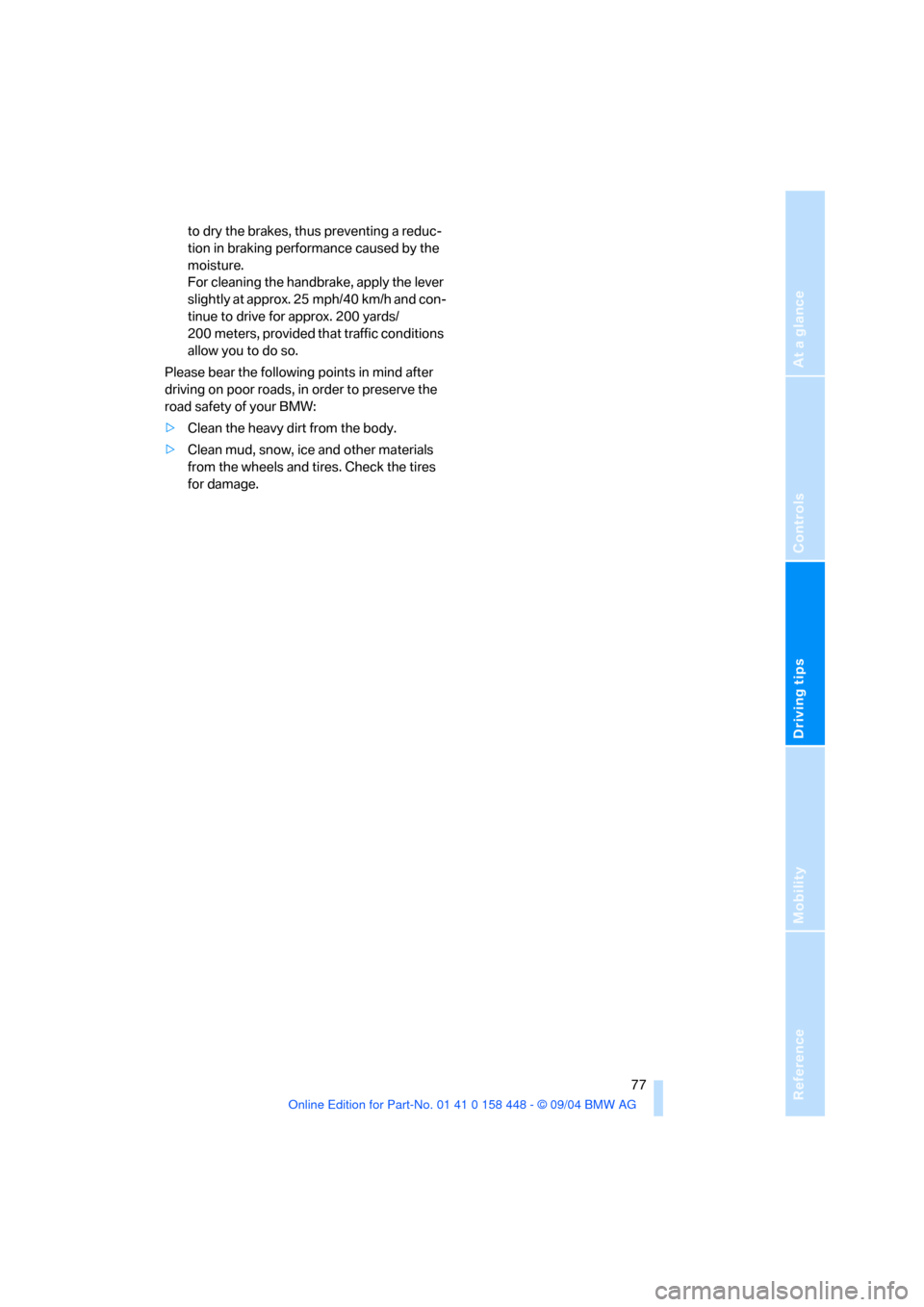
Reference
At a glance
Controls
Driving tips
Mobility
77
to dry the brakes, thus preventing a reduc-
tion in braking performance caused by the
moisture.
For cleaning the handbrake, apply the lever
slightly at approx. 25 mph/40 km/h and con-
tinue to drive for approx. 200 yards/
200 meters, provided that traffic conditions
allow you to do so.
Please bear the following points in mind after
driving on poor roads, in order to preserve the
road safety of your BMW:
>Clean the heavy dirt from the body.
>Clean mud, snow, ice and other materials
from the wheels and tires. Check the tires
for damage.
Page 80 of 126
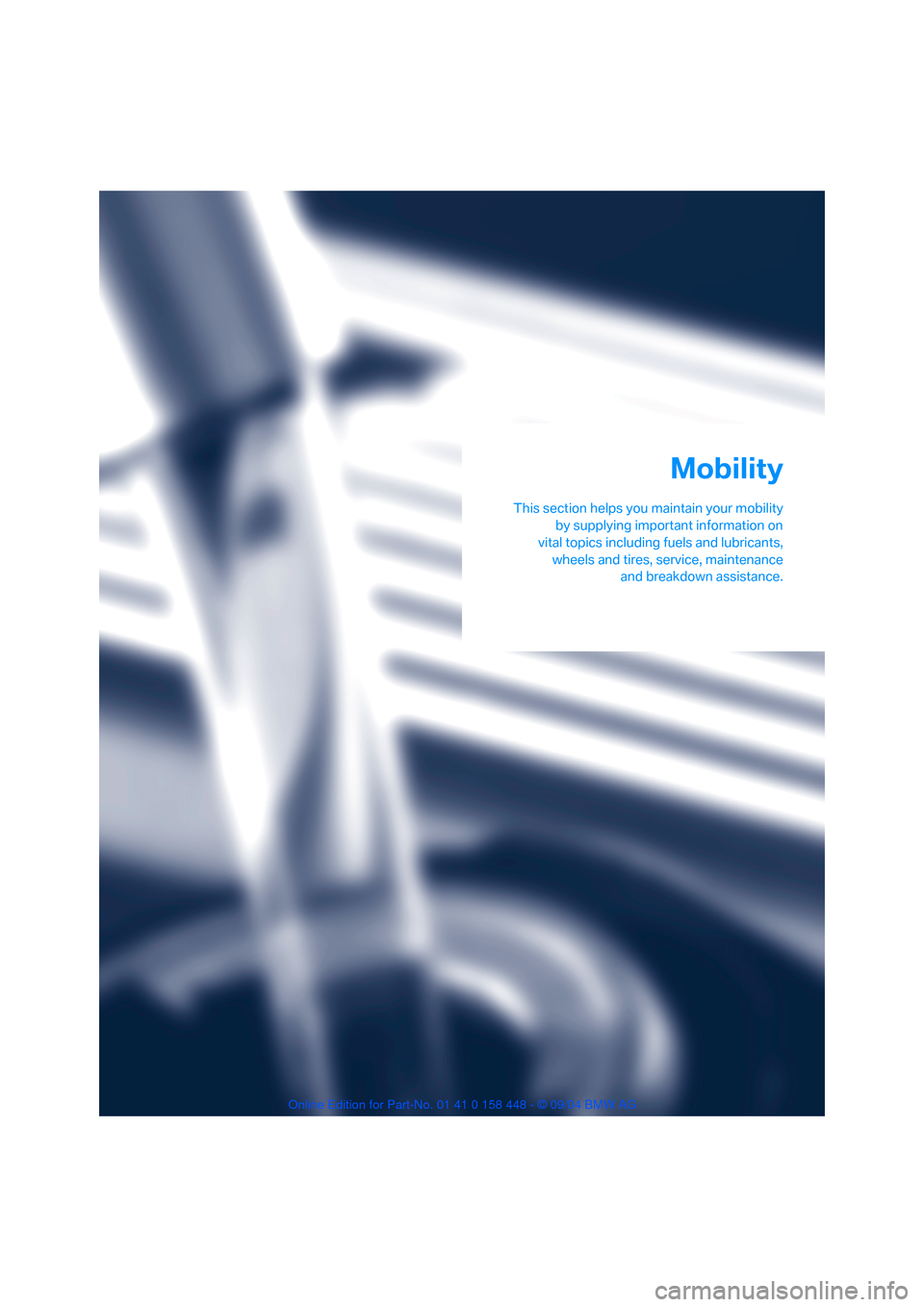
Mobility
This section helps you maintain your mobility
by supplying important information on
vital topics including fuels and lubricants,
wheels and tires, service, maintenance
and breakdown assistance.
Mobility
Page 83 of 126
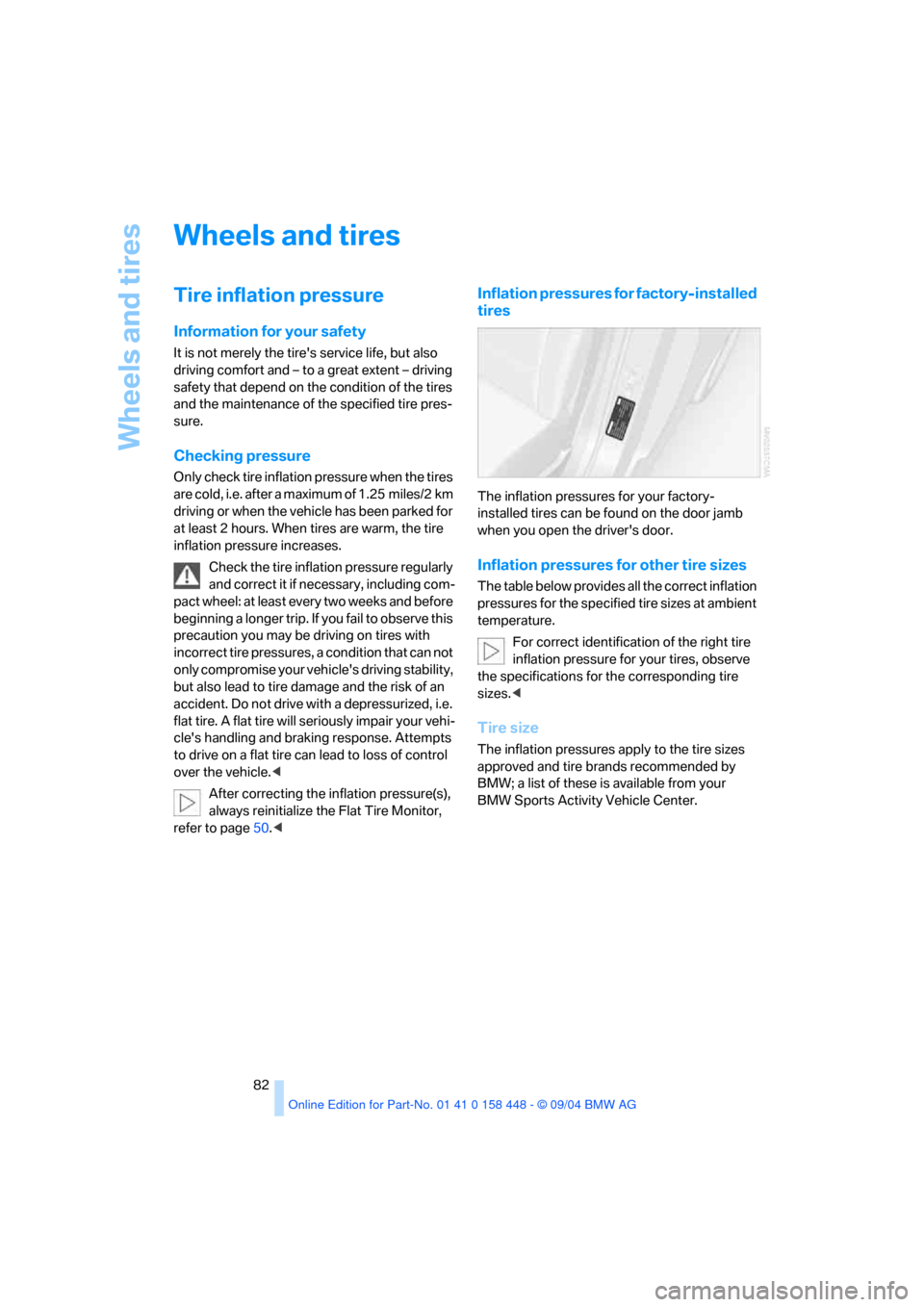
Wheels and tires
82
Wheels and tires
Tire inflation pressure
Information for your safety
It is not merely the tire's service life, but also
driving comfort and – to a great extent – driving
safety that depend on the condition of the tires
and the maintenance of the specified tire pres-
sure.
Checking pressure
Only check tire inflation pressure when the tires
are cold, i.e. after a maximum of 1.25 miles/2 km
driving or when the vehicle has been parked for
at least 2 hours. When tires are warm, the tire
inflation pressure increases.
Check the tire inflation pressure regularly
and correct it if necessary, including com-
pact wheel: at least every two weeks and before
beginning a longer trip. If you fail to observe this
precaution you may be driving on tires with
incorrect tire pressures, a condition that can not
only compromise your vehicle's driving stability,
but also lead to tire damage and the risk of an
accident. Do not drive with a depressurized, i.e.
flat tire. A flat tire will seriously impair your vehi-
cle's handling and braking response. Attempts
to drive on a flat tire can lead to loss of control
over the vehicle.<
After correcting the inflation pressure(s),
always reinitialize the Flat Tire Monitor,
refer to page50.<
Inflation pressures for factory-installed
tires
The inflation pressures for your factory-
installed tires can be found on the door jamb
when you open the driver's door.
Inflation pressures for other tire sizes
The table below provides all the correct inflation
pressures for the specified tire sizes at ambient
temperature.
For correct identification of the right tire
inflation pressure for your tires, observe
the specifications for the corresponding tire
sizes.<
Tire size
The inflation pressures apply to the tire sizes
approved and tire brands recommended by
BMW; a list of these is available from your
BMW Sports Activity Vehicle Center.
Page 84 of 126
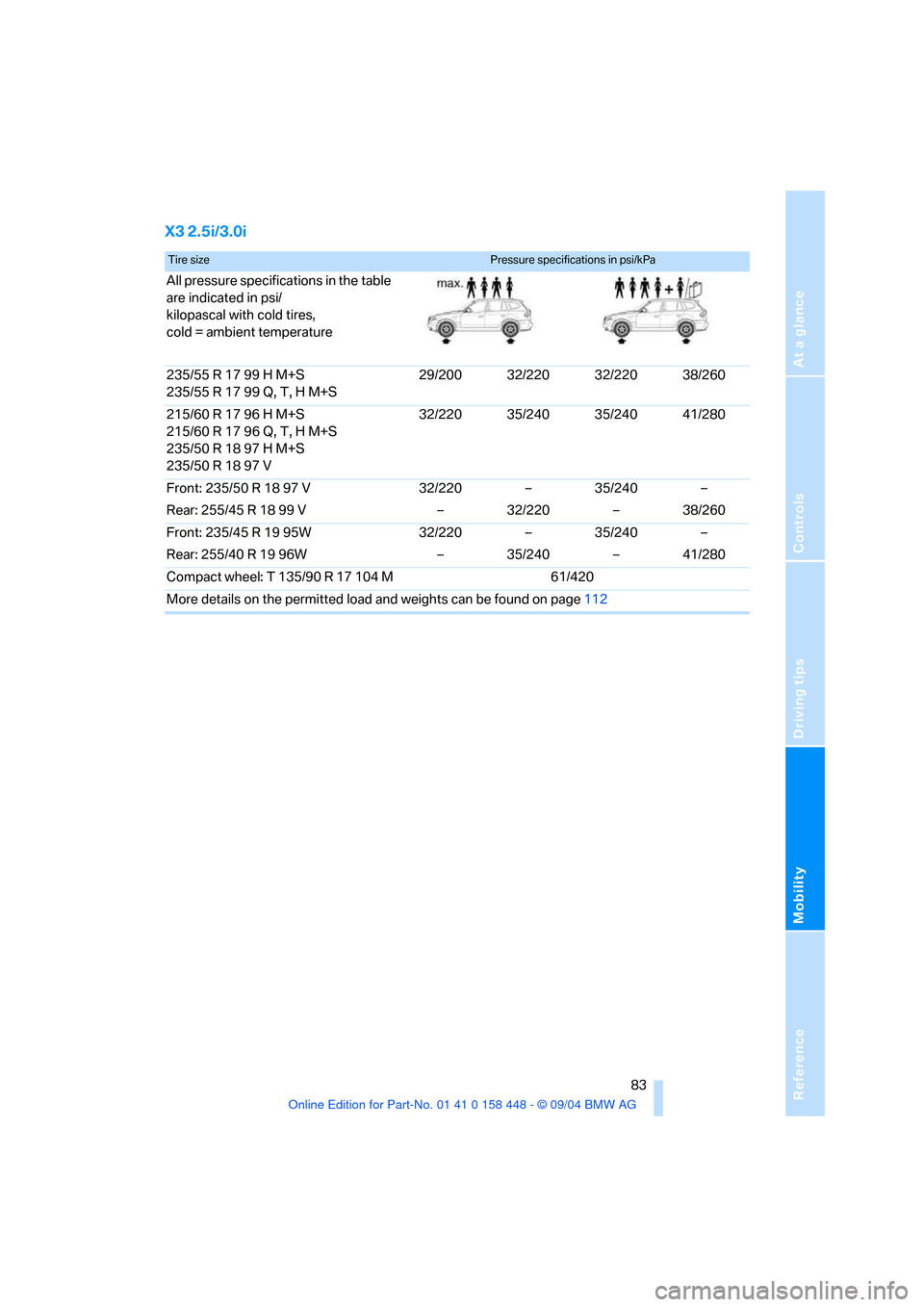
Reference
At a glance
Controls
Driving tips
Mobility
83
X3 2.5i/3.0i
Tire sizePressure specifications in psi/kPa
All pressure specifications in the table
are indicated in psi/
kilopascal with cold tires,
cold = ambient temperature
235/55 R 17 99 H M+S
235/55 R 17 99 Q, T, H M+S29/200 32/220 32/220 38/260
215/60 R 17 96 H M+S
215/60 R 17 96 Q, T, H M+S
235/50 R 18 97 H M+S
235/50 R 18 97 V32/220 35/240 35/240 41/280
Front: 235/50 R 18 97 V
Rear: 255/45 R 18 99 V32/220
––
32/22035/240
––
38/260
Front: 235/45 R 19 95W
Rear: 255/40 R 19 96W32/220
––
35/24035/240
––
41/280
Compact wheel: T 135/90 R 17 104 M 61/420
More details on the permitted load and weights can be found on page112